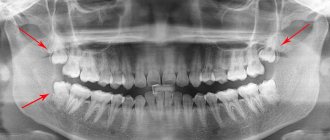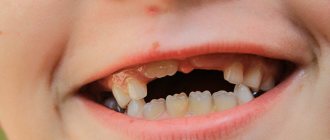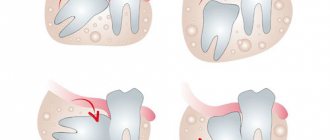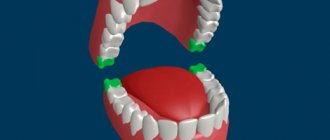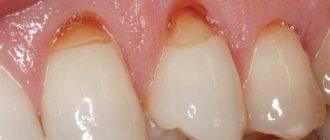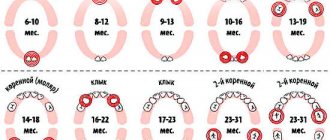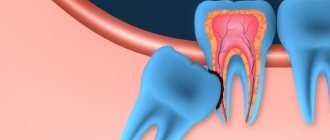A Hollywood smile doesn't always have 32 teeth. There may be only 28 if a person does not have “eights” or they have been removed. Finding out the answer to the question, at what age does the wisdom tooth grow in the upper and lower jaws, is interesting to everyone. They are the last to erupt. Not every person has them inherent in nature or are able to grow to become full-fledged participants in the dentition. 15% of women and men do not even have the rudiments of third molars (“eights”). A panoramic photo of the jaws will give an accurate answer about their presence, but at what age wisdom teeth begin to grow is difficult to predict.
Eighth tooth, figure eight, third molar: how many wisdom teeth does a person have?
In the modern world, wisdom teeth are considered something of a rudiment, that is, an organ that has lost its significance in the process of evolutionary development. That is why their appearance is greatly delayed or may not take place at all. As a rule, an adult has a maximum of 32 teeth, including 4 wisdom teeth.
However, a person can have more than 4 wisdom teeth - such cases occur quite often in dental practice! Two or more wisdom teeth may erupt, or none may appear: it all depends on the individual characteristics of the body and the structure of the dentofacial apparatus. Although a set of 32 molars is considered ideal, a number of 28 to 32 is also considered normal.
Differences between upper and lower wisdom teeth
Compared to the upper ones, the lower “eights”, as a rule, have a larger number of root canals. In addition, their removal is more difficult because the bone tissue in the lower jaw is considered denser. Otherwise, there are no significant differences.
Table of contents
- At what age are eights cut?
- Why is the wisdom tooth called that way?
- How long does it take for a number eight to grow?
- What is a wisdom tooth for?
- When are eights removed?
- Tooth extraction problems
- Is there pain when removing figure eights?
- What measures to take if you have dental problems during pregnancy?
- Complications during the eruption of wisdom teeth
- Actions prohibited for wisdom tooth pain
- What to do if the gums around a wisdom tooth are inflamed
- Is it possible to treat eights with folk remedies?
The eights in human teeth are located at the edges and this is what makes them too problematic. It is worth noting that, unlike other teeth, these grow only many years after the others have appeared, and in some cases the immediate process of their growth causes severe pain and requires their immediate removal. Statistics show the fact that not every person can always have a wisdom tooth, since during the development of the human race significant transformations took place and the jaw of modern people is 12 mm smaller relative to their ancestors, which is caused by eating softer and thermally processed food, which reduces the load on the jaw . Everyone has the germ of a wisdom tooth, but whether they grow or not depends only on physiology.
At what age are eights cut?
The replacement of a row of milk teeth with molars is carried out from 6-12 years. The eruption of wisdom teeth may not begin until the age of 21, but if they have not shown any signs of their existence before the age of 27, then it is quite possible that they will not grow at all. In medical practice, there are cases where a wisdom tooth can erupt at the age of 40, but such cases are very rare.
Why was the wisdom tooth called that way?
As already mentioned, teeth erupt before the age of 7 years, and wisdom teeth in the period 18-27 years. It is at this age that the formation of organs ends and the aging of the body actually begins. In other words, wisdom teeth begin to erupt at a time when the body has reached its maturity, which is how they get their name.
How long does it take for a number eight to grow?
How long the figure eight will grow depends on several factors. Initially, it depends on the size of the jaw a person has, as well as whether there is free space for the tooth to be normally located in its rightful place. If the jaw is too small, and there is simply no additional space for wisdom teeth to grow, then they will begin to gradually move neighboring teeth, which can last for several years, and will also cause a distortion in the evenness of the teeth.
What is a wisdom tooth needed for?
Nature has thought out each organism so carefully that each of its components, and in particular the wisdom tooth, cannot be superfluous. Some experts even call wisdom teeth rudiments, but they are often very useful in old age. It is on wisdom teeth that prosthetic bridges are placed in order to install a dental crown when other chewing teeth are removed. For this reason, dentists do not recommend immediately removing a wisdom tooth, since a banal 2-minute process can cost serious problems in the future.
When are eights removed?
Is it worth it or not to remove a wisdom tooth? This is the question that dentists are often asked by those who have encountered them. Wisdom tooth removal is the most standard surgical procedure, and to perform it, certain indicators are needed. Wisdom tooth removal is quite possible if:
- the presence of ratification of wisdom teeth, or in other words, incorrect placement of the figure eight, which can cause movement of other teeth during eruption;
- damage to wisdom teeth by caries, as this will affect the health of the root system and can affect neighboring teeth, but it is not always possible to fill the figure eight correctly and without mistakes;
- partial eruption of the wisdom tooth, which may occur due to the presence of an inflammatory process in the gum cavity;
- manifestation of pain in the trigeminal nerve;
- detection of a cyst in the cavity of the lower jaw;
- the presence of pain in the wisdom tooth, especially if it occurs when eating food;
- injury to the oral cavity if the wisdom tooth is positioned incorrectly.
Tooth extraction problems
The process of removing tooth 8 in a row can only be carried out by a qualified dental surgeon, after an x-ray. Almost always, tearing out a figure eight is painful, since its location will take a long time to heal and complications may develop. Pain, as a rule, after removal becomes the cause of the formation of alveolitis or, in other words, an inflammatory process in the socket.
Important: Ideally, the hole is covered with blood clots, which prevent the penetration of bacteria and food debris into it, therefore it is strictly forbidden to rinse the mouth after surgery. When washing out clots, you may encounter not just pain, but the formation of an infection, which will require additional surgical intervention and a long-term solution. At first, after the removal of a wisdom tooth, you may feel numbness in the cavity of the tongue, lips and even chin. If the numbness does not subside after a week, then a second visit to the doctor is required.
Is there pain when removing figure eights?
Naturally, tooth extraction is not the easiest or simplest process, and therefore many people are very worried about this and simply avoid meeting with a doctor. The operation is performed using local anesthesia. In other words, a strong painkiller is given, the type of which is discussed individually with the patient. Difficulties may arise when directly removing the figure eight, since the inconvenient location does not allow you to get close and quickly pull it out. Whether there will be severe pain after removal depends on:
- how the tooth is positioned;
- features of the root system;
- whether there are complications such as purulent inflammation, cyst or the like;
- human sensitivity threshold.
What measures should you take if you have dental problems during pregnancy?
Pregnancy is a very difficult and anxious period for every woman, but it is accompanied by a decrease in the level of calcium in the body, which primarily affects the teeth, their quality, strength and wear resistance. It is very important that no woman is immune from the fact that a wisdom tooth may start cutting or hurting.
Important: Gynecologists categorically prohibit dental treatment, regardless of their location, using anesthesia, as this has a detrimental effect on the development of the fetus. If there is a strong need, it is permissible to carry out removal or treatment only after reaching 22 weeks, since it is possible to use painkillers without harm to the baby.
Complications during the eruption of wisdom teeth
Unlike teething other teeth, eights can bring a lot of problems.
The tissue in the gum cavity near the tooth becomes inflamed. This most often manifests itself in the form of a tubercle covered with mucous membrane around the location of the figure eight. This is the so-called hood, which is injured with every meal, irritating the receptors in the mouth and thereby causing severe pain. This contributes to the formation of an inflammatory process and even the occurrence of infection with suppuration.
Sometimes it may seem that there is pain in the cheek, throat and tonsils, but it is the wisdom tooth that spreads these sensations. Only a specialist can identify and diagnose this problem, and therefore a doctor’s consultation is required to rule out the possibility of a cold.
Important: When the figure eight becomes inflamed, the whole body begins to suffer. In other words, the body temperature may rise, pain in the head, throat and even the cervical region may occur. The formation of swelling of the gums is allowed.
Actions prohibited for wisdom tooth pain
Experts do not recommend doing dental treatment on your own, or doing the following:
- warming the cheek, rinsing with hot water and applying a heating pad, as this can lead to a worsening of the condition and the occurrence of suppuration of the inflamed tissue;
- applying painkillers to the inflammation around the figure eight, which contributes to the appearance of ulcers on the tongue cavity, without relieving the pain;
- using advice from relatives, since you first need to find out the cause of pain and inflammation, and only then take measures to eliminate the problem.
What to do if the gums around the wisdom tooth are inflamed?
Intervention in the treatment of wisdom teeth on your own can cause a worsening of the condition, for example, fever, unbearable pain and similar problems. What to do if symptoms associated with the figure eight appear?
- Immediate contact with a dentist is required.
- An x-ray or, preferably, an ultrasound is required.
Important: When making a diagnosis such as the presence of suppuration, regardless of what stage of development, an immediate autopsy is required, as well as treatment and painkillers. Further development depends on the degree of complexity of the problem and on the medical indicators of the patient’s body.
Is it possible to treat eights with folk remedies?
To reduce pain during teething, you can use medications or folk remedies, but only with caution so as not to cause an allergic reaction and other serious consequences.
- The simplest method is considered to be the usual rinsing with a solution based on herbs such as sage, chamomile, oak bark or ordinary soda. It is permissible to lubricate the gums with sea buckthorn oil.
- Melissa officinalis, or to be more precise, a solution based on it is prepared immediately before use and should be stored in the refrigerator. 2 tbsp. pour 0.5 liters of boiling water, infuse for 4 hours and use for rinsing. The procedure is carried out 4 times every 24 hours, after which the composition is brewed again.
- You can boil chicory root and rinse your mouth with it. The peculiarity of the root is the presence of anti-inflammatory and analgesic effects. 250 ml of boiling water should be poured into a container with 1 tbsp. chicory root, previously thoroughly chopped. Boil the composition for 5 minutes. Next, you need to let it brew for 60 minutes, strain and rinse every 2 hours.
Important: If any problems arise with wisdom teeth, for example, pain, swelling, or even more so deformation of the teeth during eruption, you should immediately contact a dentist, a qualified specialist, for examination, consultation and taking certain measures to eliminate the problem.
Why is wisdom tooth called this?
Wisdom teeth usually begin to erupt after adulthood. Compared to other molars, which appear in childhood, we acquire wisdom teeth already as mature people, so they got their name precisely based on age. Another popular designation for wisdom teeth is third molars or “figure eights.” Here, too, everything is obvious: if you draw the midline of the face, you can see that the wisdom tooth is the eighth tooth on the left or right side.
Time of appearance of wisdom teeth
The wisdom tooth “climbs in” much later than the other teeth. “Eights” do not have rudiments in the form of milk teeth: they appear at 3–5 years, and the crown part begins to form at about 12 years, when the replacement of temporary teeth with permanent ones ends. Children's wisdom teeth usually do not emerge until they are 16 years old. The average age of their appearance is 21–25 years, but there are cases of late eruption after 30 years. Sometimes eights may not grow at all.
Many people are also interested in how long the wisdom tooth is cut (how long the wisdom tooth grows until the crown part appears above the gum). On average, this process takes from several days to a month, but the roots of the “eight” are formed several years after its eruption.
What determines the symptoms of teething?
At what age does a figure eight form? Typically, the coronal part of the element is formed by the age of 14, when the dentofacial system is fully formed. Teeth are cut much later – between the ages of 18 and 30.
The faster the tooth appears on the surface, the lower the risk of complications. The rate of tooth growth depends on the availability of free space in the oral cavity and the density of the gum tissue. Such conditions are rare, and patients usually have to contact their dentists when the last elements appear on the surface. With prolonged growth, a hood is formed near the gums, under which food debris gradually gets stuffed. This environment is optimal for the development of pathogenic flora.
The dentist helps get rid of the unpleasant symptoms of teething by opening the hood and washing it with antiseptic solutions. Sometimes the surgeon makes an incision in the gum to facilitate the process of tooth emergence. If there are clinical indications, the molar is removed without waiting for it to come out.
Symptoms of wisdom teeth erupting
Many people ask what to do if a wisdom tooth grows? The answer is obvious: contact a dentist who will monitor the entire process and be able to take the necessary measures in a timely manner if complications arise. The signs of a wisdom tooth (its eruption) are different for everyone, and some of us do not notice their appearance at all. But not everyone is so lucky: if a wisdom tooth begins to grow, then in many cases this is still accompanied by some discomfort.
How to understand that a wisdom tooth is growing?
- Inflammation and swelling of the gums appear in the eruption area.
- There is pain in the jaw area.
- The temperature rises.
- A characteristic hood forms over the coronal part of the wisdom tooth. If the tooth remains impacted (not fully erupted), the hood often becomes the cause of pericoronitis.
General recommendations for teething
What to do when third molars appear? At the first symptoms of a problem, you should consult a doctor. If this is not possible in the next few days, then at home you can also make it easier for the tooth to come out. First of all, you need to clean your mouth with a paste and brush to deactivate the pathogenic flora. After hygiene measures, the mouth is rinsed with antiseptic solutions or herbal decoctions that have an anti-inflammatory effect (calendula, chamomile, oak bark). You can use just one herbal ingredient or several herbs to relieve pain.
It is forbidden to pierce the gums with sharp objects on your own. Such actions can lead to even greater swelling of the soft tissues and the spread of infection throughout the body. It is also not recommended to constantly touch the problem area with your hands and tongue. During the visit, the dentist will ask the patient to undergo an X-ray examination to determine the integrity of the wisdom tooth and the location of its roots. If an element is affected by caries or its roots are pressing on adjacent teeth or more elements, then extraction is suggested. After tooth extraction, patients must adhere to all the specialist’s recommendations so as not to provoke complications.
Wisdom tooth root
Despite the fact that visually wisdom teeth are practically no different from ordinary molars, there are still some differences. We are talking, first of all, about root canals: in figure eights they are much more curved, so it is very difficult to carry out endodontic treatment, taking into account also where the wisdom tooth is located (in the most inaccessible area of the dentition). The number of roots of wisdom teeth also varies: there may be four or five, or maybe even one (when several canals grow together).
So what do we do with eights?
The moral of this story is this: trust qualified and educated doctors, not kind and humane “neighborly” advice. Be wise. Especially at such crucial moments in life, when wisdom teeth make themselves felt. And in general, I wonder who was the first to call them “wisdom teeth”?
Moreover, an interesting point from medical practice: if you (what if?) decide to remove the eights, it is not a fact that they will be removed for you. The reason is simple - wisdom teeth must be removed exactly according to indications. A normal doctor will never remove a healthy tooth just because you want it.
You have decided to remove your wisdom teeth. How traumatic is this?
If the wisdom tooth has grown normally, its roots are not intertwined, removal usually takes place without any complications. The edges of the tooth socket after extraction are often not even sutured.
What is most important after removing the figure eight is to allow the socket of the just removed wisdom tooth to heal. Quite a big wound.
What is absolutely impossible to do?
You should not rinse vigorously, even with such seemingly beneficial solutions as chamomile or calendula.
What needs to be done.
To get rid of food debris, you need to carefully take water into your mouth and do short oral baths without intensive rinsing. Instead of water, you can use a solution of chlorhexidine, miramistin or analogs specially sold in pharmacies - they disinfect the oral cavity. And so - for at least three days. If this recommendation is neglected, the hole may become inflamed. Then the dentist prescribes treatment with medications, including antibiotics.
What if the roots of an insidious wisdom tooth are intertwined or fused?
Unfortunately, in this case complications cannot be ruled out - soft tissues may be damaged. If an inflamed tooth is removed, in rare cases the neurovascular bundle (!) of the lower jaw is injured. In this case, separate treatment may be required.
Wisdom tooth growth: what should you be wary of?
A correctly positioned wisdom tooth (correct wisdom teeth) rarely causes discomfort to its owner, but a complex wisdom tooth can lead to very unpleasant complications. This is usually the name given to the third molar, which has an incorrect position of the rudiments or provokes complications when erupting. You need to understand that, being a rudiment, the figure eight literally wedges itself into the dentition: in some cases this happens quite organically, but in others it does not. In most situations, the culprit is incorrectly formed rudiments of wisdom teeth, located too deep, horizontally, or almost resting on neighboring teeth.
Where can I get dental care in Orenburg?
If your gums hurt where your wisdom teeth are, you can get qualified dental care in two places: public and private dental clinics. During the appointment, the dentist must:
- Conduct a preliminary examination of the oral cavity, determine the exact cause of the development of painful symptoms;
- If necessary, refer the patient for an x-ray - this procedure is often necessary in the presence of impacted wisdom teeth (completely or partially covered by gum), as well as in the case of surgical removal;
- Take the necessary measures to reduce or eliminate pain and swelling, as well as prevent further aggravation of the situation;
- If necessary, refer to a dental surgeon to remove third molars;
- Provide recommendations for further dental and oral care.
Do your gums hurt and you have symptoms of wisdom tooth growth? Seek qualified help from specialized specialists!
Complications resulting from the growth of “wise teeth”
- Malocclusion and crowded dentition.
In this case, the eighth tooth simply does not have room for normal eruption and placement. - Pressure and damage to the adjacent tooth.
If there is not enough room for the eight to grow, it begins to push against its neighbors. - Pericoronitis.
When the eruption of the figure eight is difficult, the soft tissues in this area become inflamed due to the activity of pathogenic bacteria. A so-called gum hood forms over the tooth, in which food debris accumulates, which provokes infection. The main syndrome is severe aching pain, inflammation, and sometimes purulent discharge. - Inflammation of the trigeminal nerve.
Incorrect position of the wisdom tooth can affect the trigeminal nerve, which manifests itself in the form of pain and uncontrollable twitching of the facial muscles. - Osteomyelitis and dental cyst.
Signs of growth of the eight
The emergence of a wisdom tooth to the surface is usually accompanied by pain. The discomfort is due to the fact that the bone tissue damages the gums. In addition, in place of wisdom teeth, precursors are not formed, which facilitate the process of the appearance of permanent elements. The pain when figure eights appear can be compared to the discomfort that small children experience during the process of teething. In addition to pain, other signs of the condition are also noted - itching, swelling of the soft tissues of the gums. Not in all cases, the teething process is accompanied by discomfort. Sometimes people discover a new tooth in their row completely by accident.
Other symptoms of the condition:
- swollen gums located away from the problem element;
- radiating pain to the head, ear or cheek;
- difficulty swallowing;
- the appearance of bad breath.
The last sign appears due to the fact that during the process of eruption a hood is formed above the figure eight. It is a compaction of overgrown mucous membranes. Plaque, bacteria, and food particles accumulate under the hood, eventually leading to bad breath.
In severe cases, a person develops symptoms of malaise and intoxication. Also, severe eruption of the element is accompanied by fever, inflammation of the submandibular lymph nodes, and severe headaches. Signs of the condition are individual for each person. There may be only one or many signs of a problem. The duration and intensity of the symptoms of figure eight eruption are also individual in each specific case.
Wisdom tooth hood
Why do people need wisdom teeth?
Are wisdom teeth necessary? This is perhaps one of the most common questions asked by millions of patients who come to the dentist’s office. Ancient people who lived tens of thousands of years ago had a larger and more massive jaw, so they could accommodate more teeth. This helped chew hard and tough foods. Over time, the need for this disappeared, so wisdom teeth gradually became a vestigial organ. Of course, only nature knows the exact answer to the question of why wisdom teeth grow in modern people, but one should not think that they are absolutely useless. Despite the fact that third molars are almost not involved in distributing the chewing load, wisdom teeth in adults can become a support for a prosthesis, and also prevent bone loss in the absence of neighboring molars.
What do we do after removing the eights?
We evaluate the possible damage that figure eights could cause to neighboring teeth. If the adjacent teeth are deformed, then the pathology may spread like a domino effect, and here it is already necessary to carry out systemic orthodontic treatment aimed at correcting the disturbed bite.
The most gentle and aesthetic type of dental correction today is aligners. The site provides a lot of information on aligners, but I would like to mention one undeniable advantage, namely, the patient can see the result of his treatment with aligners without even starting it! How so, you ask? The answer is simple - all future treatment of the patient is calculated using modern computer technology. The example below shows a real clinical case, a patient with crowded teeth caused precisely by the pathological effect of “eights” on neighboring teeth.
